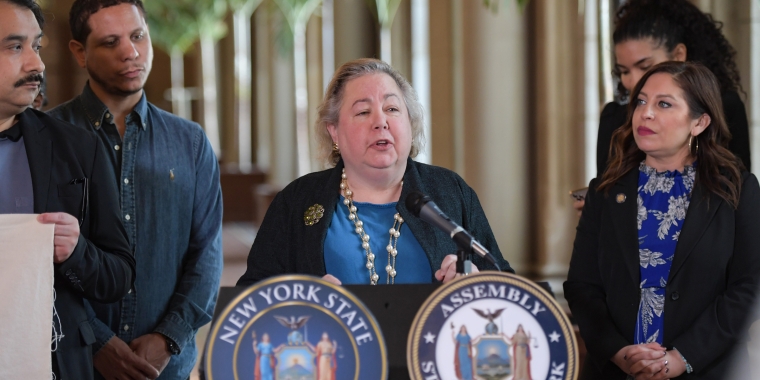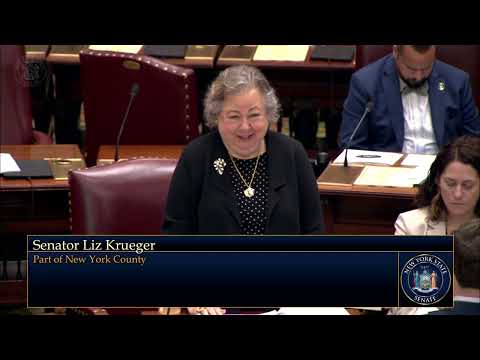
Albany Tax Deal: A Start, But Far From Done
Our Town, December 15, 2011
By Liz Krueger
In another whirlwind session in Albany, Gov. Andrew Cuomo pushed through a new tax plan that will generate $1.5 billion in much needed additional revenue for the state. I supported the plan because that revenue will make it easier to balance the budget without devastating cuts to education, health care and social services, and because it creates a more progressive tax structure than we would have if we did nothing. But there is also plenty to be critical of, both in terms of the minimal progressive reform to our tax structure and the record-breaking 26 minutes the Legislature and public had to review the contents of the package.
Most of the discussion of taxes in the last year or so has focused on extending some version of the high-income earner surcharge, or “Millionaires’ Tax,” which expires at the end of 2011. I supported extending this tax as necessary, recognizing that the hardship caused by our poor economic climate needs to be shared and that the burden is currently falling disproportionately on the poor and middle classes. But I have always believed there were better options, such as increasing the number of PIT tax brackets and indexing for inflation, which could generate revenue while creating a fairer tax structure.
While the package that was adopted last week uses the model of increasing the number of brackets as a means to promote progressivity, it does so in a particularly timid way and ends up being substantially less progressive than the expiring surcharge.
Under the new plan, while people making over $2 million will pay a rate of 8.82 percent, almost as large as the 8.97 percent they pay under the expiring millionaires’ tax, people making between $500,000 and $2 million will get a very substantial 1.14 percent decrease in their tax rate, which will revert to the previous top rate of 6.85 percent. At the same time, those making between $40,000 and $150,000 will see their tax rate decrease a mere .4 percent, to 6.45 percent. A truly progressive reform could have done a lot more for the middle class if it didn’t focus so much on protecting those making $500,000 or more.
Of course what we passed was better than the alternative of doing nothing. Then, when the millionaires’ tax expired, a single person making $20,000 or a couple making $40,000 would pay the same tax rate as people making 10, 20 or even 100 times more. Since the rich often have interest, dividend and capital gains income that is taxed at a lower rate, the actual tax rate paid by the very wealthy is often less than that paid by lower-income individuals.
Rushing through complex changes to tax policy at the request of the governor without allowing bills to age three days can make for bad policy, since things get done without the careful review of consequences, whether intended or unintended. I have long been critical of the use of messages of necessity to pass legislation—in fact, I sued the state over it a few years ago.
One issue that has already been raised is that the provisions in the same tax bill reducing payroll taxes dedicated for the MTA appear to have weakened “lockbox protections” for MTA funding passed into law earlier his year. While Governor Cuomo has stated he is committed to replacing the revenue the MTA will lose due to the reduction in the payroll tax, these changes may make it harder to enforce that commitment or even to know they have been violated.
While this package clearly doesn’t get everything right, it at least starts us down the road to fundamental reform of our tax system, something I have long advocated for. I also believe we need to go beyond simply looking at the income tax.
As chair of the Select Committee on Budget and Tax Reform for 2009-2010, I explored a variety of ideas about how to modernize personal income, sales and business taxes. While I believe that such changes can and should enhance state revenues, it is also clear that reforming our outdated tax structure could encourage economic development by creating a more transparent and equitable system that rewards models that increase living wage job creation and ends wasteful tax expenditures that create uneven playing fields for small and medium businesses while decreasing our tax base.
My goals for tax reform are two-fold. First, we need to ensure our tax structure is providing adequate revenue to support vital public services and that the burdens of taxes are equitably distributed. Second, we need to bring our tax structure into the 21st century and make sure that we use it to encourage economic development. This week, we took some steps toward these goals, but much remains to be done to created the modern, progressive tax system New York needs.



